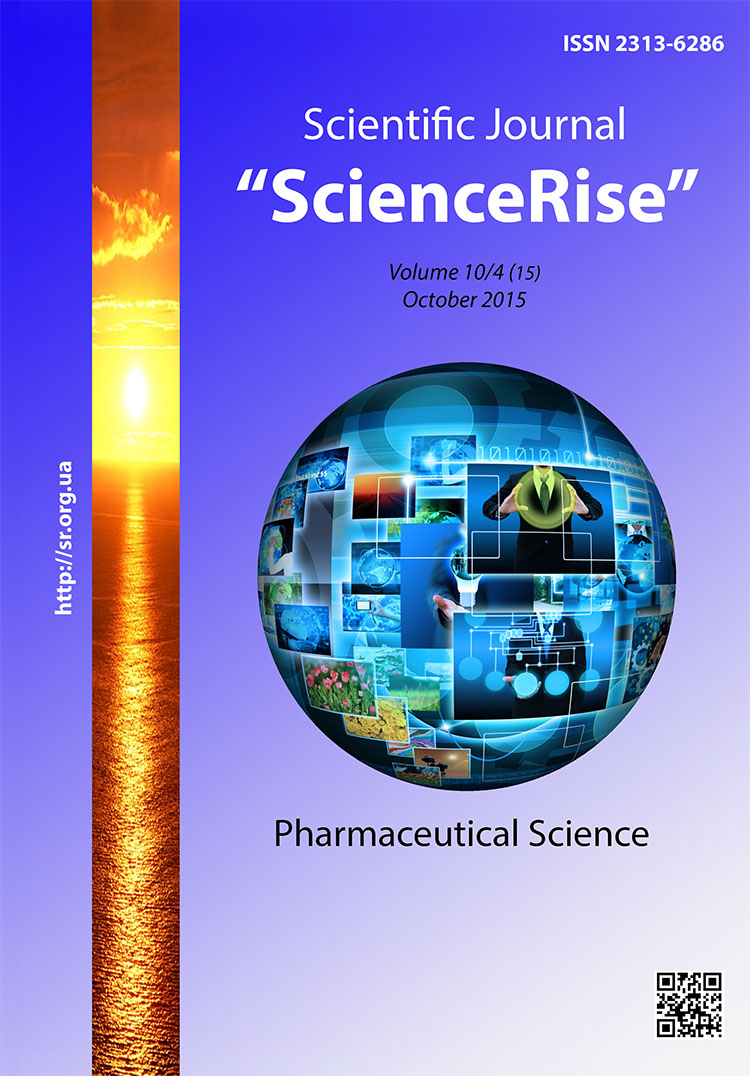Cefadroxil iodometric determination by potassium hydrogenperoxomonosulfate reaction
DOI:
https://doi.org/10.15587/2313-8416.2015.52004Keywords:
cefadroxil, iodometric determination, potassium hedronperoxomonosulphate, β-lactam antibiotic, quantitative determination, sulfoxideAbstract
Aim. Simple methods of oxidimetric determination of β-lactam antibiotic cefadroxil in pure powder and in capsules, that are based on S-oxidation reactions by potassium hydrogenperoxomonosulphate acid in weak acid medium to S- oxide with following iodometric quantitative determination of the oxydator reagent excess were developed.
Materials and methods. A triple potassium salt of caroate acid, 2KHSO5•KHSO4•K2SO4 (commercial «Oxone®» DuPont, production) was used as oxidizing agent.
Results. By the results of reaction kinetics using iodometric titration it was determined that redox reaction between cefadroxil and potassium hydrogenperoxomonosulfate is quantified and a stoichiometric: 1 mol of cefadroxil is per 1 mol of potassium hydrogen. Quantitative oxidation of Sulfur atom was finished in the time that is less than 1 min. The mean recovery of the main substance in the cefadroxil pure substance was 97.76%, RSD=1.33 % (δ=1.31 %), 1 mL of the standard 0.0200 mol L-1 sodium tiosulphate solution corresponds to 0.003634 g of sodium cefadroxil (C16H17N3O5S) which should be 95–102 % in the pure anhydrous substance. The mean recovery of medical preparation “Cefadroxil”, 500 mg is 100.06 %, RSD=0.96 % (δ=1.01 %), which should be 92.5–107.5 %, in anhydrous preparation. The limit detection is С=0.05 mg mL-1. The advantages of the proposed procedure are the ability to assay cefadroxil by the biologically active part of the molecule (alicyclic and tiomethyl sulfur), good recovery and the accuracy of results.
Conclusions. The obtained validation data meet the requirements of the State Pharmacopoeia of Ukraine, which indicates the possibility of its introduction in the practice of analytical laboratories analysis, or application during the stepwise control process or manufacturing of drugs quality control during equipment washing
References
Metwally, F. H., Alwarthan, A. A., Al-Tamimi, S. A. (2001). Flow-injection spectrophotometric determination of certain cephalosporins based on the formation of dyes. Il Farmaco, 56 (8), 601–607. doi: 10.1016/s0014-827x(01)01100-4
Mrestani, Y., Neubert, R. H. H., Härtl, A., Wohlrab, J. (1997). Determination of cephalosporins in urine and bile by capillary zone electrophoresis. Analytica Chimica Acta, 349 (1-3), 207–213. doi: 10.1016/s0003-2670(97)00279-1
Emaldi, P., Fapanni, S., Baldini, A. (1995). Validation of a capillary electrophoresis method for the determination of cephradine and its related impurities. Journal of Chromatography A, 711 (2), 339–346. doi: 10.1016/0021-9673(95)00520-w
Sastry, C. (1998). New spectrophotometric method for the determination of some drugs with iodine and wool fast blue BL. Talanta, 45 (6), 1227–1234. doi: 10.1016/s0039-9140(97)00237-3
McAteer, J. A., Hiltke, M. F., Silber, B. M., Faulkner, R. D. (1987). Liquid-chromatographic determination of five orally active cephalosporins – cefixime, cefaclor, cefadroxil, cephalexin, and cephradine--in human serum. Clinical Chemistry, 33 (10), 1788–1790.
Thongpoon, C., Liawruangrath, B., Liawruangrath, S., Wheatley, R. A., Townshend, A. (2005). Flow injection chemiluminescence determination of cephalosporins in pharmaceutical preparations using tris (2,2′-bipyridyl) ruthenium (II)-potassium permanganate system. Analytica Chimica Acta, 553 (1-2), 123–133. doi: 10.1016/j.aca.2005.07.056
Samanidou, V. F., Hapeshi, E. A., Papadoyannis, I. N. (2003). Rapid and sensitive high-performance liquid chromatographic determination of four cephalosporin antibiotics in pharmaceuticals and body fluids. Journal of Chromatography B, 788 (1), 147–158. doi: 10.1016/s1570-0232(02)01040-1
Sun, Y. (2004). Potassium permanganate?glyoxal chemiluminescence system for flow injection analysis of cephalosporin antibiotics: cefalexin, cefadroxil, and cefazolin sodium in pharmaceutical preparations. Talanta, 64 (1), 156–159. doi: 10.1016/j.talanta.2004.02.012
Ivaska, A., Nordström, F. (1983). Determination of some cephalosporins by differential pulse polarography and linear scan voltammetry. Analytica Chimica Acta, 146, 87–95. doi: 10.1016/s0003-2670(00)80595-4
Salem, H., Saleh, G. A. (2002). Selective spectrophotometric determination of phenolic β-lactam antibiotics. Journal of Pharmaceutical and Biomedical Analysis, 28 (6), 1205–1213. doi: 10.1016/s0731-7085(02)00027-4
Salem, H. (2004). Selective spectrophotometric determination of phenolic β-lactam antibiotics in pure forms and in their pharmaceutical formulations. Analytica Chimica Acta, 515 (2), 333–341. doi: 10.1016/s0003-2670(04)00380-0
Downloads
Published
Issue
Section
License
Copyright (c) 2015 Юлія Юріївна Сердюкова (Лабузова), Світлана Григорівна Леонова

This work is licensed under a Creative Commons Attribution 4.0 International License.
Our journal abides by the Creative Commons CC BY copyright rights and permissions for open access journals.
Authors, who are published in this journal, agree to the following conditions:
1. The authors reserve the right to authorship of the work and pass the first publication right of this work to the journal under the terms of a Creative Commons CC BY, which allows others to freely distribute the published research with the obligatory reference to the authors of the original work and the first publication of the work in this journal.
2. The authors have the right to conclude separate supplement agreements that relate to non-exclusive work distribution in the form in which it has been published by the journal (for example, to upload the work to the online storage of the journal or publish it as part of a monograph), provided that the reference to the first publication of the work in this journal is included.

